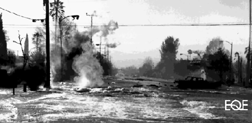
This fire on Balboa Boulevard in Granada Hills destroyed several homes and was caused by an unusual sequence of events. Adjacent water and gas mains broke because of ground failure (possible faulting). According to eyewitnesses, the truck stalled because of the flooding, and when the driver attempted to restart the vehicle, the leaking gas was ignited.
The earthquake affected a densely built-up, primarily low-rise area, with Modified Mercalli Intensities ranging from VII to IX. The area has a population of about 3 million, with fire protection provided primarily by the Los Angeles (City) Fire Department (LAFD), complemented by local departments in the jurisdictions of San Fernando, Glendale, Burbank, and Pasadena. Los Angeles County Fire Department provides protection in portions of the central Los Angeles Basin, as well as outlying areas of the county, while Ventura County is protected by a number of local fire departments. At the time of this writing, data collection was still underway for a number of these jurisdictions; therefore, the information presented here covers primarily the epicentral area.
LAFD reported 476 nonmedical incidents occurring from 4:38 A.M. (that is, 7 minutes after the earthquake) until 11:41 P.M. on January 17. This contrasts with a typical daily total of 50 to 100 nonmedical incidents. A total of 79 of these incidents occurred between 4:38 A.M. and 6:11 A.M., at which time LAFD lost its computer-aided dispatch capability. Loss of computer-aided dispatch was caused by a malfunction of backup power supplies, and it forced the LAFD dispatch to switch to manual mode. Reconstruction from audio tapes indicated a total of 230 incidents during the subsequent 7 hours (that is, until 1:37 P.M.), until sufficient backup power had been restored. These incidents included all structural fires as well as a number of other nonmedical incidents requiring fire department response, such as structural investigation. Specific incidents included loss of many mobile homes at several mobile home parks (see previous section on “Mobile Homes and Implications for Fire Following”); loss of several commercial structures in Northridge, Tarzana, and Sherman Oaks; and a major hazardous materials fire in the science complex at California State University, Northridge.
-
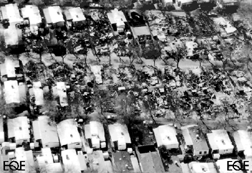
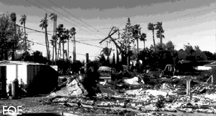
Right: The remains after a fire in a mobile home development that destroyed at least 36 homes.
Left: The remains of a few of the homes destroyed by the fire on Balboa Boulevard.
Other jurisdictions affected by the earthquake included Santa Monica, Culver City, San Fernando, Beverly Hills, Burbank, Glendale, Pasadena, and portions of Ventura County. The Ventura County Fire Protection District had more than 300 incidents, including 20 structural fires. Santa Monica had 16 earthquake-related fires, and Burbank had one. Data for these jurisdictions are being collected.
Structural damage to three LAFD fire stations caused their evacuations. The most damaged station was in Northridge and was constructed in 1979 as a three-bay reinforced masonry building with two stories adjacent to the apparatus bays.
-
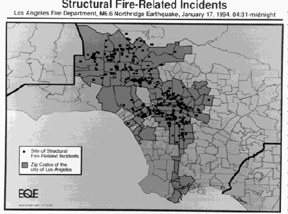
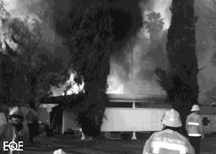
Left: A map of structural fire-related incidents reported to the Los Angeles Fire Department on the day of the earthquake. Five to 10 times the normal number of incidents occurred.
Right: Residential fire in Northridge two days after the earthquake. Fire fighters were still hampered by lack of water in the neighborhood to fight the fire. The only water available to fight this fire was from water tenders (tanker trucks) supplied by the Riverside County Fire Department.00_EQE_contents.htm